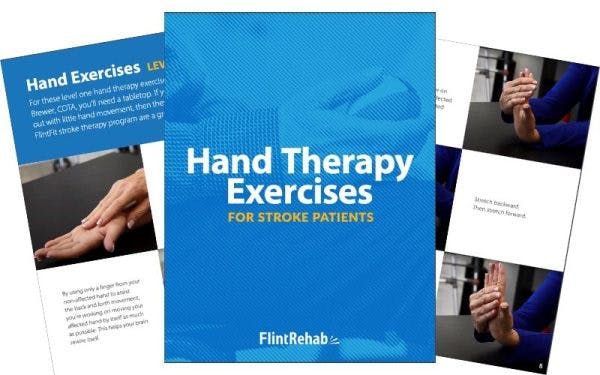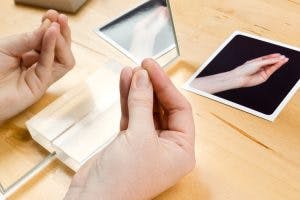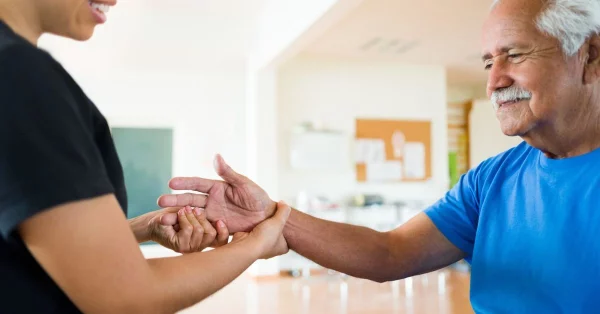Recovering after a stroke takes time, patience, and a lot of practice. Every movement from lifting a fork to tying a shoe helps your brain and body reconnect. One of the best ways to speed that process along is through repetitive task training.
If you’ve ever been told, “practice makes progress,” this is exactly what that means in stroke rehab. In this article, we’ll explain why repetition and repetitive task training is such a powerful part of recovery. Plus we’ll share 8 simple ways to stay consistent with your training, even on tough days.
What Is Repetitive Task Training?
Repetitive task training means practicing the same functional movement over and over like reaching, grasping, or standing up with the goal of improving how your body performs that activity. It’s not about random motions or strength drills but about real-life tasks that help you regain independence.
The reason this works has everything to do with your brain’s ability to heal itself, a process called neuroplasticity. After a stroke, certain brain cells may be damaged, but other areas can step in and take over if they’re trained to do so.
And how do you train them? By repeating meaningful, purposeful movements again and again.
Imagine you’re clearing a new path through tall grass. The first few times are hard. But the more you walk it, the easier it becomes to follow. That’s exactly how repetition strengthens new brain pathways.
According to a 2017 study published in the journal Stroke, repetitive task training has been demonstrated to improve:
- Arm function
- Hand function
- Lower limb function
- Walking distance
- Functional ambulation ability
With all of these potential benefits, it is easy to see why repetitive task training is an effective method to promote recovery after stroke.
Why Repetition and Repetitive Task Training Is So Powerful for Stroke Recovery
Here’s why therapists emphasize repetition so much and why it should be at the heart of your daily rehab routine.
1. It Helps Your Brain Relearn Movement
Every time you repeat a movement, your brain sends signals through specific nerve pathways. Doing it again and again helps those pathways grow stronger. Over time, movements that once felt difficult can become smoother and more natural.
2. It Improves Coordination and Control
At first, motions might feel jerky or weak. Repetitive task training and repetition in general help to retrain your muscles and nervous system to work together again. It’s how you go from barely lifting your arm to grabbing a cup confidently.
3. It Builds Confidence
Seeing progress, even small progress, can be incredibly motivating. Each time you complete a task a little better than before, it reinforces your belief that recovery is possible.
4. It Leads to Greater Independence
Repetitive task training focuses on the movements you actually use every day. The more you practice those real-world actions, the more likely you are to do them on your own, whether that’s brushing your teeth, buttoning a shirt, or walking across the room.
What Repetitive Task Training Looks Like in Practice
You don’t need a fancy gym or expensive equipment to benefit from repetitive task training. It can be done almost anywhere, using simple movements that mimic daily life.
Here are a few examples:
- Hand exercises: Repeatedly grasping and releasing objects like small balls, cups, or therapy putty.
- Coordination activities: Grasping and manipulating small objects, like coins, game pieces, or a set of keys.
- Reaching practice: Moving an item from one shelf to another, or stacking lightweight objects.
- Walking drills: Taking short, repeated steps forward and backward, focusing on balance and form.
- Interactive tools: Using devices like MusicGlove, which turns hand movements into a rhythm-based game.
- Full-body systems: Programs like FitMi, which guide you through hundreds of repetitions in fun, interactive ways.
The goal is to perform high numbers of meaningful repetitions, not just move for the sake of moving. Quality and consistency matter most.
What the Research Says About Repetitive Task Training
Animal studies have shown that the brain needs a surprisingly large number of repetitions to create real change, often hundreds of repetitions per day. Other studies have estimated that between 1,000 and 10,000 total repetitions of a task are necessary to create lasting changes in the brain.
In traditional rehab sessions, patients might only perform around 30 repetitions of a task. But when survivors use home-based programs or motivating tools, they can easily reach 300, 400, or more repetitions.
The takeaway: the more you practice, the more your brain learns. Repetition literally teaches your brain how to move again.
The Hard Part: Staying Consistent
Anyone who’s gone through stroke recovery knows that staying consistent isn’t always easy. Progress can feel slow, motivation can fade, and fatigue can hit hard. But building a daily habit of repetition is what drives long-term success.
Let’s look at eight practical ways to make consistency easier and even enjoyable.
8 Tips to Stay Consistent With Repetitive Task Training
1. Choose Tasks That Matter to You
The best way to stay motivated with repetitive task training is to make your exercises meaningful. If a movement connects to something you love or miss doing, your brain stays more engaged.
Love gardening? Practice scooping soil or watering plants with your affected arm. Enjoy cooking? Try stirring or chopping motions safely with supervision.
When your exercises connect to real life, they don’t just feel like therapy but they feel like you getting back to your normal self!
2. Keep It Short and Doable
You don’t need hour-long sessions to make progress. In fact, shorter, more frequent practice can often be better for your brain.
Try breaking your exercises into small sessions throughout the day, maybe 20-30 minutes at a time. This keeps your energy up and helps you reach a higher total number of repetitions without getting overwhelmed.
Think of it like brushing your teeth: it’s just something you do automatically, every day.
3. Track Your Progress
It’s easy to forget how far you’ve come. Keeping a simple log of what you practice and how it feels can help you see improvement over time.
Write down the number of repetitions you do, how your movement feels, or what you were able to accomplish that week.
Many therapy devices and apps (like the FitMi or MusicGlove) automatically track your progress to give you a visual reminder of your hard work paying off.
4. Create a Routine
Having a set time each day to do your therapy and get those repetitions in makes it easier to stick with. Pick a time when you usually have the most energy, maybe in the morning after breakfast or mid-afternoon after a nap.
You can even pair your therapy with an existing habit, like doing your exercises right before watching your favorite show. Over time, your brain begins to expect that routine, and consistency becomes automatic.
5. Make It Fun
Repetitive task training doesn’t have to be dull. Try to find ways to make your training enjoyable:
- Play music while you move
- Use therapy games that give instant feedback
- Turn exercises into small challenges (“Can I do 10 more than yesterday?”)
That’s one of the things that make game-like rehab tools, such as the MusicGlove, great. They turn repetitive hand movements into a rhythm game which makes practice feel more like play.
6. Involve Family or Friends
Having someone cheer you on makes a huge difference. Ask a family member, friend, or caregiver to help with exercises, count repetitions, or simply keep you company.
They can also help with setup or give gentle reminders when it’s time to practice. Sharing your goals with loved ones can boost accountability and make rehab a team effort instead of a solo mission.
7. Celebrate Every Win
Progress in stroke recovery often happens in small steps. Maybe your hand opened a little easier today, or you managed an extra five repetitions.
Celebrate those victories! Acknowledging small gains builds momentum and keeps you focused on how far you’ve come instead of how far you still want to go.
You can even reward yourself with something like your favorite TV show, or a special treat for when you finish your exercises each day!
8. Use Visualization to Rest When You Need To
Consistency doesn’t mean pushing through pain or exhaustion. Listen to your body. Some days you’ll have more energy than others and that’s okay.
If your muscles are tired or you feel discouraged, take a short break, do a lighter session, or focus on visualization (imagining yourself performing the movements). Visualization actually activates similar brain pathways as physical movement and can keep progress going even during rest days.
How Many Repetitions Should You Do to Maximize Your Stroke Recovery Sessions?
There’s no magic number that fits everyone, but studies suggest that 300–400 repetitions per day can lead to real improvement.
That might sound like a lot, but when you break it into smaller sets throughout the day, it becomes manageable. For example:
- 100 repetitions in the morning
- 100 at lunch
- 100 in the evening
To break it up even more, you could try to do just 30 repetitions each hour throughout the day, or even simply between breakfast and dinner time. Tools that count repetitions for you can make it easier to stay on track without worrying about the numbers.
How Therapists Use Repetition in Rehab
During formal therapy, your occupational or physical therapist designs sessions filled with repetitive movements. You might do the same reaching or walking drills dozens of times with their guidance.
They do this because they know repetition builds skill, and they’ll often encourage you to continue practicing at home between visits.
In recent years, therapists have started using technology like robotic devices, virtual reality, or home therapy systems to help patients achieve higher numbers of repetitions in an engaging way. These tools help to bridge the gap between clinic and home practice.
Why Home Practice Makes Such a Big Difference
Your therapist might only see you a few hours each week, but what you do at home fills in the rest of the puzzle.
That’s why at-home tools like FitMi and MusicGlove are so helpful. They’re designed specifically for stroke survivors and make it easy to complete hundreds of repetitions in a fun, motivating way.
- FitMi encourages full-body movement with interactive feedback.
- MusicGlove helps retrain the hand and fingers through rhythm-based play.
These programs give you structure, variety, and progress tracking, three ingredients that help you stay consistent for the long haul.
Bringing It All Together
Repetitive task training is one of the most effective ways to rebuild movement after stroke. Each repetition teaches your brain something new, strengthens connections, and builds the foundation for independence.
Consistency, not perfection, is what drives progress. By choosing meaningful activities, tracking your success, making practice enjoyable, and listening to your body, you can make repetition a natural part of your recovery routine.
Every small movement counts because each one is a signal to your brain that healing is still happening. With patience, persistence, and a bit of creativity, those repetitions can add up to real, lasting change.









